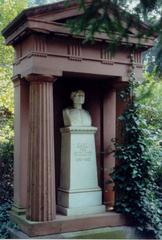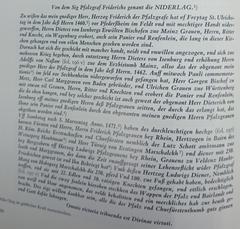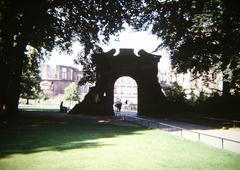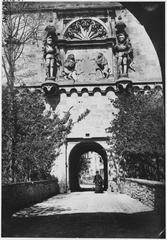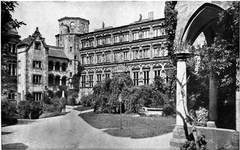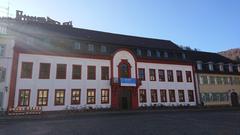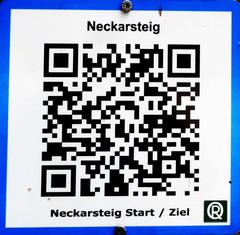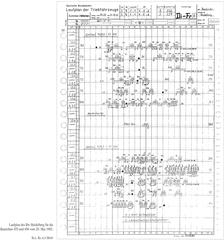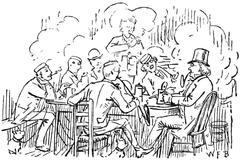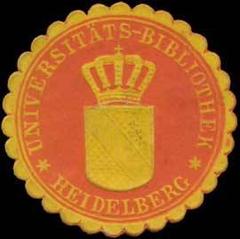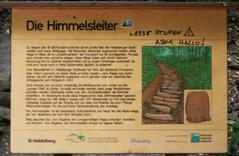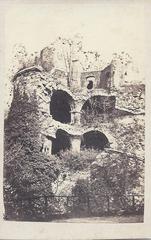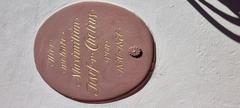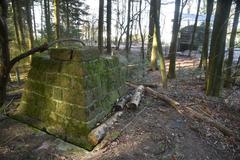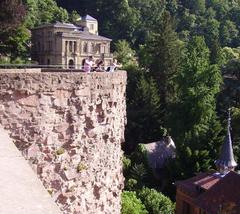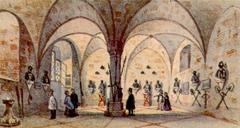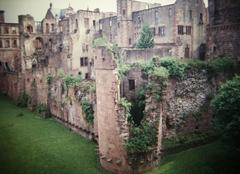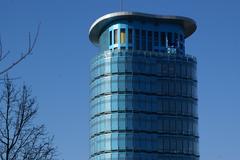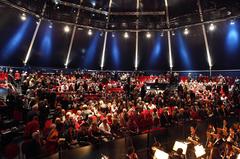
Heidelberg Tun: Visiting Hours, Tickets, and the Ultimate Guide to Heidelberg’s Historic Barrel
Date: 04/07/2025
Introduction to the Heidelberg Tun
Nestled in the cellars of Heidelberg Castle, the Heidelberg Tun (Großes Fass) is a marvel of engineering and a vibrant symbol of the Palatinate region’s wine culture. Crafted in 1751 from 130 oak trees, this colossal barrel once held over 221,700 liters of wine, making it one of the largest wine barrels ever built (Amusing Planet). More than a feat of craftsmanship, the Tun embodies Heidelberg’s economic, political, and festive history, enchanting visitors with tales of legendary figures like Perkeo, the castle’s jovial court jester. Today, the Tun remains a highlight for tourists from around the globe, offering an immersive experience into Heidelberg’s romantic and cultural legacy.
This comprehensive guide covers the history and significance of the Heidelberg Tun, practical visitor details—including opening hours, ticketing, and accessibility—plus tips for exploring the castle and surrounding attractions. Whether you’re a history enthusiast, wine lover, or cultural traveler, this guide will help you make the most of your visit to one of Germany’s most iconic historical sites.
For up-to-date information, always refer to the official Heidelberg Castle website and the FTRC Blog.
Table of Contents
- Introduction
- The History of the Heidelberg Tun
- Cultural and Symbolic Importance
- Visitor Information
- Photography and Souvenirs
- Frequently Asked Questions (FAQ)
- Conclusion and Call to Action
- Visuals and Media Suggestions
- Sources and Further Reading
The History of the Heidelberg Tun
Construction and Origins
The Heidelberg Tun’s origins trace back to the late 16th century, with the current barrel crafted in 1751 under Prince Elector Karl Theodor (Amusing Planet). The Tun is the fourth—and largest—of its kind built at Heidelberg Castle. For its construction, over 130 oak trees were used, resulting in a barrel measuring 7 meters wide and over 8 meters long (Everything Explained Today). Originally, its capacity was 221,726 liters, though it has diminished slightly due to wood shrinkage over the centuries (Wikipedia).
Purpose and Symbolism
The Tun was designed to store wine collected as taxes from local winemakers, reflecting the Electors Palatine’s economic clout and the region’s agricultural richness (Atlas Obscura). While the barrel was largely ceremonial due to leakage issues, it became a symbol of abundance, prestige, and the Electors’ power. Its presence in the castle cellar was intended to impress visitors and dignitaries, serving as a monumental display of regional prosperity (Explorial).
The Legend of Perkeo
The most famous figure associated with the Tun is Perkeo, the court jester and official wine taster. His legendary appetite for wine and witty humor made him a local icon, with his name stemming from his catchphrase “Perché no?” (“Why not?”) when offered another drink (Malorie’s Adventures). Visitors can spot his statue beside the Tun, and his story is celebrated in local festivals and lore.
Survival Through the Ages
Despite wars and changing fortunes, the Heidelberg Tun has endured. While tales abound of invading soldiers trying to tap its reserves, most such stories are more myth than fact (Amusing Planet). Preservation efforts, particularly in the 19th century, have ensured that the Tun and the castle remain central to Heidelberg’s historical identity.
The Tun in Literature and Art
The giant barrel has inspired writers and artists for centuries. Mark Twain, Victor Hugo, and others have referenced it in their works, often exaggerating its size and significance for dramatic or comic effect (Wikipedia). Anton Praetorius’s 16th-century poem “Vas Heidelbergense” even celebrated the Tun as a symbol of Calvinist pride (Everything Explained Today). Today, the Tun is a frequent motif in art and souvenirs, reinforcing its place in Heidelberg’s cultural memory.
Cultural and Symbolic Importance
Wine Culture and Regional Identity
The Tun serves as a monument to the Palatinate’s centuries-old wine tradition. Its immense scale and placement underscore the importance of viticulture in the region’s economy and social life (Explorial). Today, it hosts events and tastings, keeping the tradition alive.
Political and Religious Symbolism
Beyond wine, the Tun was a demonstration of political strength and religious identity, particularly during the Reformation when it was lauded as a Calvinist triumph (Wikipedia). Its sheer size was intended to awe visitors and reinforce the Electors’ legitimacy.
Tourist Icon
Now a top tourist attraction, the Tun draws hundreds of thousands of visitors yearly. The platform atop the barrel—once a dance floor—offers a unique vantage point and remains a highlight for photographs and events (Atlas Obscura).
Visitor Information
Location and Access
- Address: Heidelberg Castle, Schlosshof 1, 69117 Heidelberg
- How to Get There: Take the funicular railway (Bergbahn) from the Kornmarkt in Heidelberg’s Old Town. The ride is scenic and included with your castle ticket. For those arriving by car, parking is available at the castle’s base, with a short uphill walk to the entrance (Penguin and Pia; The Tourist Checklist).
Visiting Hours and Ticketing
- Opening Hours: Generally open daily from 9:00 AM to 6:00 PM, with last admission 30 minutes before closing. Seasonal variations may apply (Official Heidelberg Castle Website).
- Tickets: Standard adult admission is approximately €8–€11 and includes the funicular, castle courtyard, the Tun, and the German Pharmacy Museum. Children under 6 enter free. Discounts are available for students and seniors.
- Guided Tours: Available in multiple languages, with specialized and themed tours offered throughout the year. Audio guides are also available for an additional fee.
Accessibility
- The funicular is wheelchair accessible; however, the route to the Tun includes stairs and uneven cellar floors, which may limit access for those with mobility impairments (The Tourist Checklist). Assistance is available on request; check the castle website for detailed accessibility information.
Tips for Your Visit
- Timing: Arrive early or visit on weekdays for a quieter experience.
- Footwear & Clothing: Wear sturdy, comfortable shoes and bring a light jacket, as the cellars are cool year-round.
- Photography: Photos are encouraged, but tripods may be restricted during busy times.
- Facilities: Restrooms, a café, and a gift shop (selling local wines and Tun-themed souvenirs) are available on-site.
Nearby Attractions
- German Pharmacy Museum: Included with your ticket, this museum offers a fascinating look at medical history.
- Castle Gardens: Free to visit and perfect for panoramic views and relaxation.
- Heidelberg Old Town: Easily accessible by funicular or foot, the Altstadt features charming streets, shops, and cafes (Eat Sleep Breathe Travel).
- Philosophenweg (Philosopher’s Walk): A scenic trail with stunning views of the castle and city.
Photography and Souvenirs
- Best Photo Spots: The platform atop the Tun and the Great Terrace overlooking the Neckar River and Heidelberg Old Town are highly recommended.
- Souvenirs: The castle shop offers miniature Tun replicas, wine glasses, and local wines—ideal keepsakes for visitors.
Frequently Asked Questions (FAQ)
Q: What are the Heidelberg Tun’s visiting hours?
A: Heidelberg Castle and the Tun are generally open from 9:00 AM to 6:00 PM, with seasonal variations. Always check the current schedule on the official website.
Q: How much do tickets cost?
A: Standard adult tickets are around €8–€11, with discounts for students, seniors, and children.
Q: Are guided tours available in English?
A: Yes, guided tours and audio guides are available in multiple languages, including English.
Q: Is the Heidelberg Tun wheelchair accessible?
A: The funicular and main courtyard are accessible, but the Tun’s cellar involves stairs and uneven floors, which may limit access.
Q: Can I take photos inside?
A: Photography is permitted, though tripods may be restricted during busy periods.
Q: Can visitors enter the Tun?
A: The interior of the barrel is closed, but visitors may climb the stairs to the platform atop the Tun.
Conclusion and Call to Action
The Heidelberg Tun is more than a monumental barrel—it’s a living symbol of Heidelberg’s heritage, blending history, legend, and celebration. By planning your trip around current visiting hours, ticketing options, and accessibility needs, you’ll ensure a smooth and memorable experience at this iconic site. Explore related attractions within the castle and Old Town, enjoy panoramic views, and delve into centuries of winemaking tradition.
For updates, ticket purchases, and interactive resources, visit the official Heidelberg Castle website. Enhance your visit with the Audiala app for audio guides and real-time information. Share your experiences, explore more of Heidelberg’s treasures, and immerse yourself in the unique legacy of the Heidelberg Tun.
Visuals and Media Suggestions
- Photos: Show the Tun from various angles, the Perkeo statue, and panoramic views from the castle terraces.
- Maps: Highlight the funicular route and the Tun’s location within the castle complex.
- Videos/Virtual Tours: Access these via the official castle website and major travel portals.
Sources and Further Reading
- The Gigantic Wine Barrel of Heidelberg, Amusing Planet
- Heidelberg Tun, Wikipedia
- Heidelberg Tun, Everything Explained Today
- The Heidelberg Tun and the Legend of Perkeo, Malorie’s Adventures
- 10 Fun Facts About Heidelberg, Explorial
- Top Heidelberg Historical Sites to Visit, FTRC Blog
- Things to Do in Heidelberg, Penguin and Pia
- Heidelberg Castle Visitor Information, Official Heidelberg Castle Website
- Travel Blog: Heidelberg Castle, TravelYesPlease
- 25 Interesting Facts About Heidelberg Castle, World’s Facts







